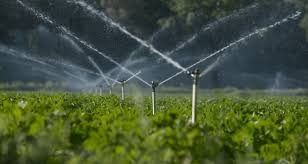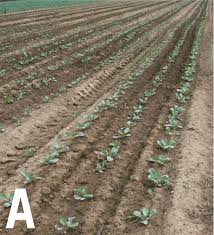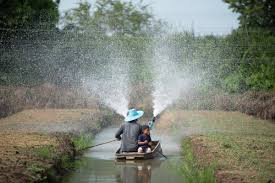Most vegetable plants contain about 90 percent water, with some, such as lettuce, reaching up to 95 percent. The critical factor is not the water content within the plant, but the amount of water passing through the plant during its life cycle.
Irrigation is necessary when natural rainfall is insufficient, to keep the small leaf openings (stomata) open. This allows the plant to absorb carbon dioxide from the air, enabling continuous photosynthesis and production of carbohydrates for further growth.
Water stress causes stomata to close, followed by plant wilting and potential damage from overheating. Crop loss begins when wilting occurs.
The rate of water transpiration through stomata depends mainly on solar radiation, temperature, humidity, and wind speed. Soil acts as a water reservoir, and the available water depends on soil type and crop rooting depth.
Deep-rooted crops access a larger soil volume for water than shallow-rooted ones. Soil can hold a maximum water amount called ‘field capacity’. As soil dries, available water decreases until the ‘permanent wilting point’, where roots can no longer absorb water, despite some moisture remaining.
The difference between field capacity and wilting point is the ‘available soil moisture’, which varies by soil type. Irrigation is vital for reliable crop yields. Although some crops like sweet potato and sorghum tolerate drought, yield decreases under moisture stress.
Read Also: Cutworms: How to Identify and Get Rid of Cutworms
The Concept of Water Management and Irrigation in Agriculture

Water is a crucial input for crop production, required continuously and in large amounts throughout plant growth. It significantly affects photosynthesis, respiration, nutrient absorption, translocation, and utilization.
Both water shortage and excess impact plant growth, development, yield, and quality. Soil irrigation is necessary to:
i. Remove stress conditions
ii. Release nutrients in the soil solution for plant absorption
iii. Leach harmful salts from the soil
iv. Prepare land for crop cultivation
v. Maintain soil temperature, humidity, and micro-climate for optimal microbial activity
vi. Ensure proper aeration and functioning of roots and shoots
vii. Remove excess water that causes unworkable soil conditions
Irrigation: Artificial Water Application During Dry Seasons
Irrigation is the artificial application of water to crops when natural rainfall is insufficient, to promote rapid growth and increase yields.
Successful crop production depends on efficient irrigation, influenced by factors such as frequency, duration, intensity, source, and method of water supply. Factors affecting irrigation supply include:
1. Topography and soil characteristics
2. Type of plant (root depth, water absorption, growth habit)
3. Weather conditions
i. Determining When to Irrigate
Irrigation timing is critical and is indicated when new leaves show wilting signs, slightly before full wilting occurs. Leaf shedding in orchards signals water stress.
ii. Determining How Much to Irrigate
Here is your list with lowercase Roman numerals and spaced for clarity:
i. If water is limited, light but frequent irrigation is advised
ii. If water is abundant, heavier irrigation with longer intervals is appropriate
iii. Inadequate irrigation reduces growth and fruiting
iv. Over-irrigation can cause waterlogging, nutrient leaching, and poor fruit quality
v. Plants recovering from drought should receive gradual irrigation to prevent fruit and bark splitting
Read Also: 15 Medicinal Health Benefits of Ficus Deltoidea (Misletoea Fig)
Irrigation Systems Used in Agriculture

Different irrigation systems are applied depending on location and crop needs. The best system balances moisture seepage and evaporation. Main irrigation systems include:
i. Surface Irrigation: Flooding, Basin, Furrow, Ring systems
ii. Sub-Surface Irrigation: Trench method, Underground pipelines, Perforated pipelines
iii. Overhead or Aerial Irrigation: Sprinklers, Revolving nozzles
iv. Drip or Trickle Irrigation
A. Surface Irrigation Systems
1. Flooding: Water enters from one end on flat land, flooding the area. Common in canal or tank beds, it allows bullock-drawn tools but wastes water, causes soil erosion, encourages weeds, and spreads diseases like gummosis in citrus and collar rot in papaya.
2. Basin System: Circular basins surround tree trunks, connected in series, fed by a main channel. This reduces water loss compared to flooding but may spread diseases near the trunk and transfer nutrients between basins.
3. Furrow System: Water flows by gravity through furrows between crops on raised beds. It is widespread but less efficient unless land is well contoured and soil is uniform.
Furrows are placed about 4 inches apart depending on tree age. Suitable for moderate slopes (1-2%). A disadvantage is uneven water distribution, causing growth variation.
4. Ring System: An improved basin system where water is directed into a ring around the tree base, recommended for citrus trees to reduce collar rot risk.
The ring size increases with tree growth. This method prevents some diseases but requires more labor and capital and does not distribute water as uniformly as the basin system.
B. Sub-Surface, Overhead, Sprinkler, and Drip Irrigation Systems
1. Sub-Surface Irrigation: Water is delivered underground through perforated pipelines to maintain the water table near roots. This method requires caution to avoid waterlogging and salt accumulation.
It is unsuitable if soil permeability is very low or if irrigation water has high salt content. Land leveling is critical for uniform watering.
2. Overhead or Aerial Irrigation: Water is sprayed like rainfall via low-pressure pipes and nozzles. Application rates are high (about 1 inch/hour), suitable for sandy or gravelly soils with high infiltration. Revolving nozzles apply water at 0.2 to 0.3 inches per hour.
3. Sprinkler Irrigation: Requires pumps and sprinklers but may lead to uneven water application, causing either water wastage or insufficient soil moisture. It suits new land, rough terrain, porous or shallow soils, and small water sources like wells.
Fertilizers can be applied through this method (fertigation). Disadvantages include high cost, wind sensitivity, nozzle clogging, interference with pollination, and labor needs for system maintenance. Wet foliage can increase disease risk.
4. Drip or Trickle Irrigation: The most efficient system, using low water pressure and delivering water directly to the root zone via pipelines and nozzles near the soil surface or buried. It maintains soil moisture, reduces nutrient leaching, and supports fertigation.
Common in high-value crop production, greenhouses, and glasshouses. Disadvantages include high initial cost and the need for filtered water to prevent clogging. Pressure regulation is necessary on uneven terrain.
Do you have any questions, suggestions, or contributions? If so, please feel free to use the comment box below to share your thoughts. We also encourage you to kindly share this information with others who might benefit from it. Since we can’t reach everyone at once, we truly appreciate your help in spreading the word. Thank you so much for your support and for sharing!

